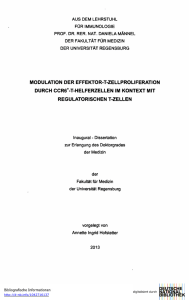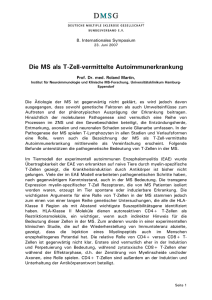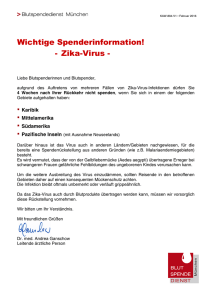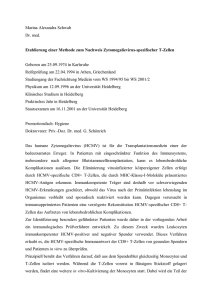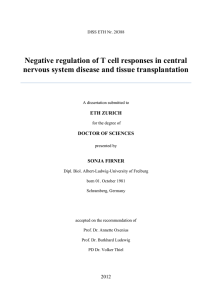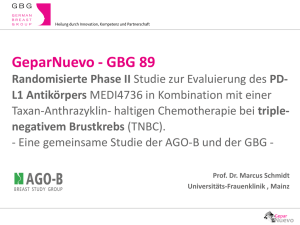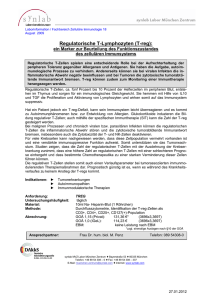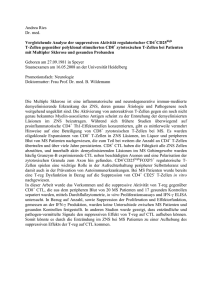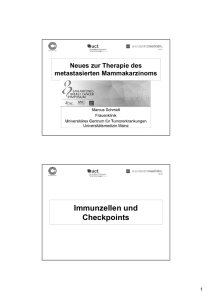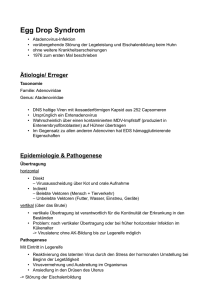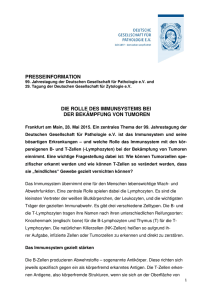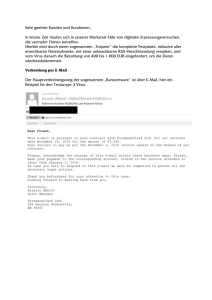Negative immuneregulation during persistent - ETH E
Werbung
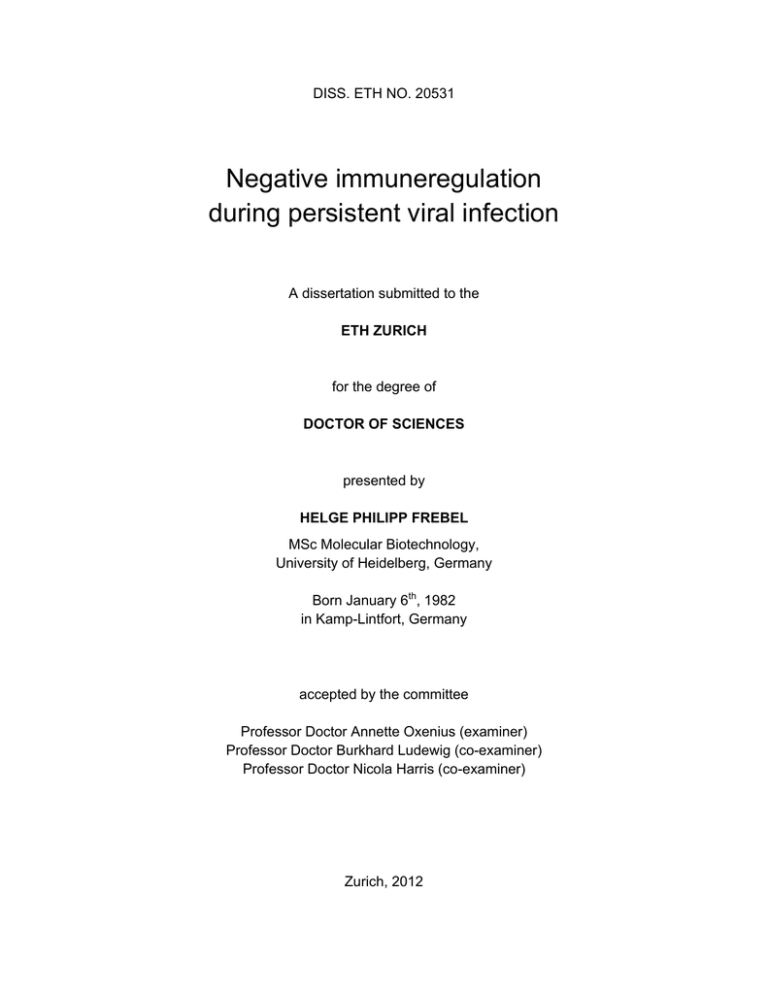
DISS. ETH NO. 20531 Negative immuneregulation during persistent viral infection A dissertation submitted to the ETH ZURICH for the degree of DOCTOR OF SCIENCES presented by HELGE PHILIPP FREBEL MSc Molecular Biotechnology, University of Heidelberg, Germany Born January 6th, 1982 in Kamp-Lintfort, Germany accepted by the committee Professor Doctor Annette Oxenius (examiner) Professor Doctor Burkhard Ludewig (co-examiner) Professor Doctor Nicola Harris (co-examiner) Zurich, 2012 1.1. English summary Persistent virus infections are a major health concern, particularly in the case of human immunodeficiency virus (HIV) and hepatitis C virus (HCV) infections. An inherent characteristic of persistent virus infections is the inability of anti-viral adaptive immunity to clear the pathogen. This failure is intimately linked to the progressive loss of T cell effector functions commonly observed during persistent infections. Recent studies discovered negative immuneregulation through co-inhibitory pathways to contribute to the silencing of anti-viral T cell responses and thus to facilitate viral persistence. However, despite promoting microbial persistence, co-inhibitory pathways might also play a crucial protective role by suppressing excessive virus-directed T cell responses. It therefore is essential to identify the immunological processes which are controlled by negative regulatory pathways during persistent virus infections to completely understand the spectrum of their functions. We set out to investigate the protection conferred by the co-inhibitory programmed death 1 (PD-1)/programmed death ligand 1 (PD-L1) pathway in a prototypic mouse model of persistent virus infections. PD-1 deficient mice were found to succumb to a rapidly developing fatal pathology in conditions of high systemic loads of lymphocytic choriomeningitis virus (LCMV) during the early phase of infection. Impaired PD-1/PD-L1 signaling precipitated significantly enhanced effector functions of anti-viral CD8 T cells which manifested in modestly improved virus control and aggravated liver pathology. More importantly, PD-1 deficient CD8 T cells increasingly killed LCMV infected vascular endothelial cells in a perforin-dependent manner, as endothelial cells protected themselves from T cell-mediated cytotoxicity through the upregulation of PD-L1. Enhanced endothelial cell apoptosis compromised vascular integrity and resulted in considerably elevated vascular permeability. The consequential leakage of plasma caused the formation of alveolar edema, while the intravascular depletion of fluid impacted on circulatory homeostasis in form of critically decreased blood pressure. This severe progressive hypotension ultimately culminated in fatal circulatory collapse. A further project dealt with another mechanism of negative immuneregulation which was suspected to contribute to the functional silencing of anti-viral T cells during persistent virus infection. The regulatory T cell (Treg) compartment was compared during resolved and persistent LCMV infection with respect to its size, phenotype and developmental origin. A significant expansion of Treg was observed during persistent but not during resolved 2 10. infection, while both populations exhibited comparable phenotypes and suppressive capacities. Further investigations suggested the expansion of Treg not to result from the conversion of conventional anti-viral CD4 T cells to the induced Treg lineage. This was confirmed by a genome-wide transcriptional profiling and differential expression analysis of anti-viral CD4 T cells from resolved and persistent LCMV infection which did not determine a higher expression level of FoxP3 in the latter population. This analysis moreover suggested anti-viral CD4 T cells from persistent infection to be regulated by the same co-inhibitory pathways than already described for anti-viral CD8 T cells. 1.2. German summary Chronische Virusinfektionen stellen eine grosse gesundheitliche Herausforderung dar, was besonders auf Infektionen mit dem Humanen Immundefizienz Virus (HIV) und dem Hepatitis C Virus (HCV) zutrifft. Eine zwingende Eigenschaft chronisch viraler Infektionen ist die Unfähigkeit der anti-viralen adaptiven Immunität, ein Pathogen zu eliminieren. Dieses Versagen ist eng mit dem zunehmenden Funktionalitätsverlust von T-Zellen verbunden, welcher im Allgemeinen während chronischer Virusinfektionen beobachtet wird. Jüngste wissenschaftliche Studien belegen, dass negative Immunregulation durch ko-inhibitorische Signale zu einer Abschwächung der anti-viralen T-Zell Antwort und damit zur viralen Persistenz beiträgt. Allerdings könnten ko-inhibitorische Signale ebenfalls eine protektive Rolle spielen, indem sie übersteigerte anti-virale T-Zell Antworten mindern. Aus diesem Grund ist es essentiell, die immunologischen Prozesse zu identifizieren, welche von negativen regulatorischen Signalen während chronischer Virusinfektionen kontrolliert werden, um das komplette Spektrum ihrer Funktionen zu verstehen. Daher untersuchten wir in einem vorherrschenden Maus Modell für chronische virale Infektionen den Schutz, welcher durch den ko-inhibitorischen programmed death 1 (PD-1)/programmed death ligand 1 (PD-L1) Signalweg vermittelt wird. Es zeigte sich, dass PD-1 defizitäre Mäuse bei hohen systemischen Titern des Lymphozytären Choriomeningitis Virus (LCVM) in der frühen Phase der Infektion einer sich schnell entwickelnden fatalen Pathologie erlagen. Eine Unterbrechung des PD-1/PD-L1 Signalwegs führte dabei zu einer signifikant verstärkten Funktionalität anti-viraler CD8 T-Zellen, die sich in Form von leicht verbesserter Viruskontrolle aber verstärkter Leberpathologie manifestierte. Außerdem töteten 12. 3 PD-1 defizitäre CD8 T-Zellen in einem durch Perforin vermittelten Mechanismus verstärkt LCMV infizierte vaskuläre Endothelzellen, welche sich nicht mehr durch die erhöhte Produktion von PD-L1 gegen T-Zell-vermittelte Zytotoxizität schützen konnten. Die zunehmende Apoptose von Endothelzellen kompromittierte infolgedessen die vaskuläre Integrität, was eine deutlich erhöhte vaskuläre Permeabilität herbeiführte. Das daraus resultierende Entweichen von Plasma führte zum Entstehen alveolärer Ödeme, während der intravaskuläre Verlust von Flüssigkeit sich durch ein kritisches Absinken des Blutdrucks auf die zirkuläre Homöostase auswirkte. Letztlich führte eine schwere progressive Hypotonie zu tödlichem Kreislaufversagen. Ein weiteres Projekt untersuchte einen zusätzlichen negativen immunregulatorischen Mechanismus, welcher im Verdacht stand, zu der funktionalen Abschwächung anti-viraler T-Zellen im Rahmen chronisch viraler Infektionen beizutragen. Die Population regulatorischer T-Zellen wurde in Bezug auf Größe, Phänotyp und Ursprung während einer aufgelösten und einer chronischen LCMV Infektion verglichen. Eine signifikante Expansion regulatorischer T-Zellen konnte während der chronischen aber nicht während der aufgelösten Infektion festgestellt werden, während beide Populationen vergleichbare Phänotypen und Suppressionspotentiale aufwiesen. Zusätzliche Untersuchungen legten nahe, dass die beobachtete Expansion regulatorischer T-Zellen nicht aus der Differenzierung konventioneller anti-viraler CD4 T-Zellen zu induzierten regulatorischen T-Zellen resultierte. Dies wurde durch eine Genom-weite Transkriptionsanalyse sowie eine Analyse der differentiellen Transkription in anti-viralen CD4 T-Zellen aus einer aufgelösten und einer chronischen LCMV Infektion bestätigt, da die Analyse keine erhöhte Expression von FoxP3 in der letzteren Population feststellte. Zudem legten diese Ergebnisse nahe, dass anti-virale CD4 T-Zellen im Rahmen einer chronischen Infektion durch die gleichen ko-inhibitorischen Signalwege reguliert werden, wie es bereits für anti-virale CD8 T-Zellen beschrieben worden ist. 4 10.
